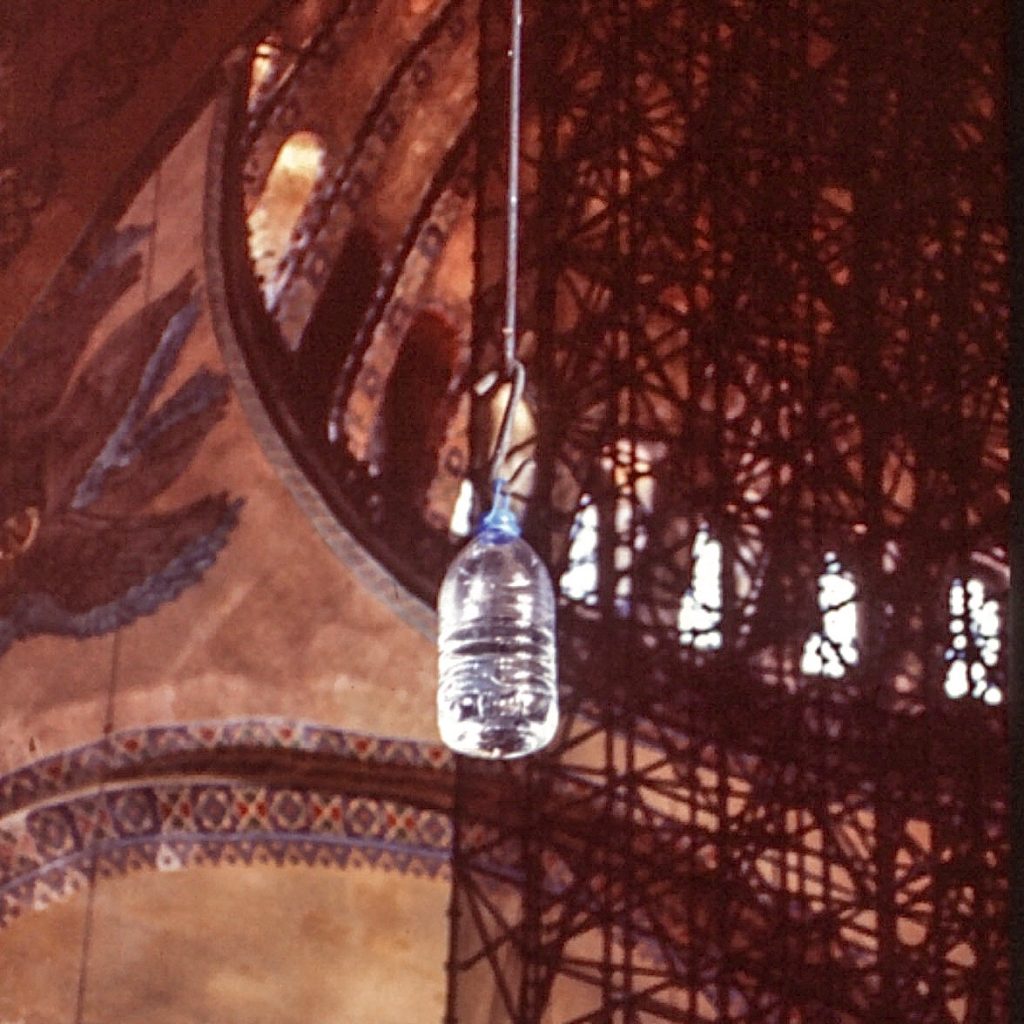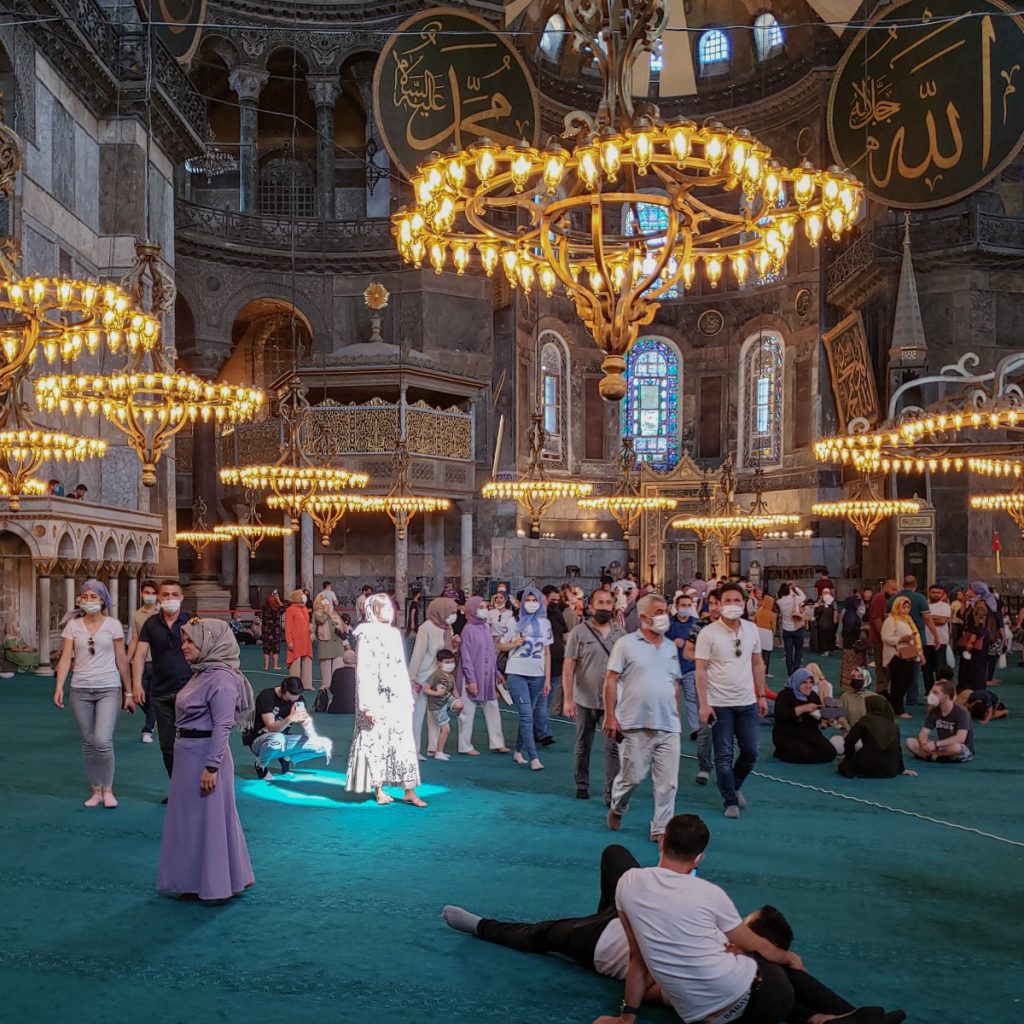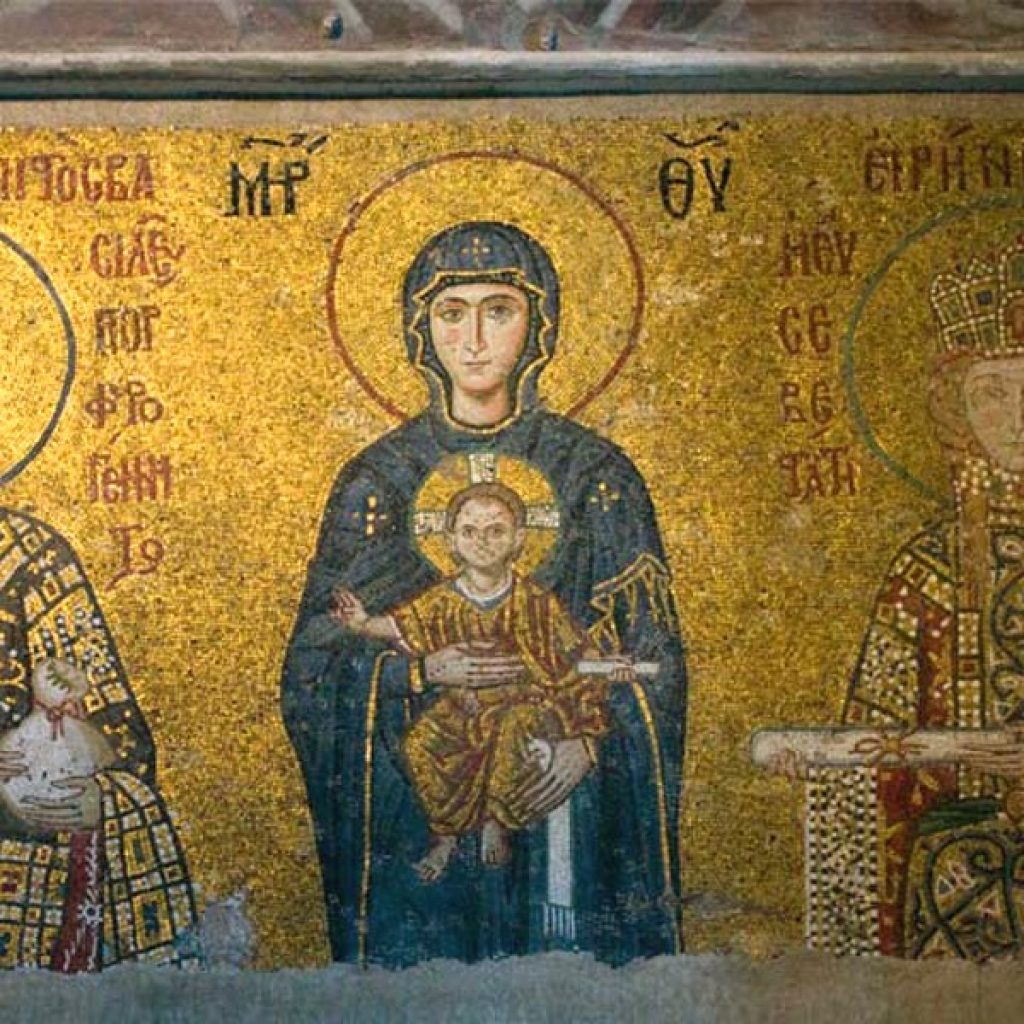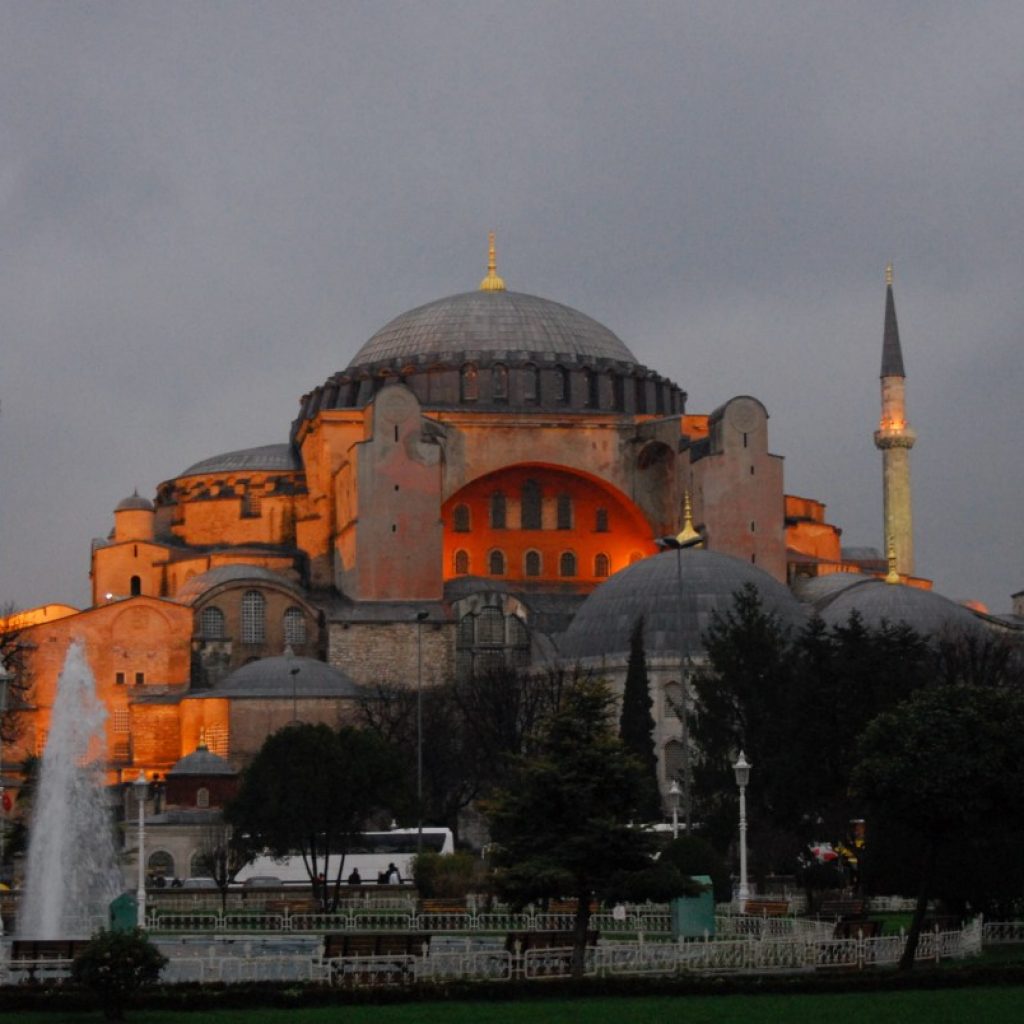By Hakan Topal – Hyperallergic –
I recently visited the Hagia Sophia for the first time after its conversion and felt overwhelming sadness.
On the occasion of the 2003 Istanbul Biennial, American artist Tony Feher (who died in 2016) developed a new artwork specifically for the Hagia Sophia Museum. Feher was known for installations that skillfully engaged architectural space by incorporating everyday industrial materials such as water bottles, painter’s tape, chains, string, zip ties, and glass marbles. After a long deliberation process, Feher installed “Nature is Over”(2003) on the second floor of the museum. Composed of blue tape applied delicately to second-floor windows, the installation also featured a plastic bottle hung from an iron chandelier. Feher’s work in this majestic space alluded to the religious stained-glass tradition by minutely changing the quality of the light. His work focused on the power of illumination, hence the additional chandelier in the form of a mere plastic bottle, creating a surprising contrast with the authentic architectural elements.

Considering its entangled histories spanning the East Roman Empire to the Byzantium, the Ottoman Empire to the modern republic, and alternately used as a basilica, mosque, and secular museum space, the Hagia Sophia is one of the world’s most important historical structures. Built in the 6th century with a dome 32.6 meters in diameter, it is an engineering marvel even by today’s standards. It has endured many significant earthquakes and wars. In the second half of the 16th century, the great Ottoman architect, Mimar Sinan studied Hagia Sophia carefully and built additional supporting walls to strengthen it.
Converted to a museum in 1934 and designated as the UNESCO World Heritage site in 1985, the Hagia Sophia had been a welcoming educational space. One could observe beautiful examples of Christian (Greek Orthodox and Latin Catholic) iconography and Islamic ornamentation side by side. The museum brought forward not a “clash of civilizations” but the aggregation of cultures — a place for reflection about empires, civilizations, conflicts, and new possibilities of coexistence in modern societies. Its doors were open to new encounters; it hosted many art exhibitions over the years, allowing heterogeneous experiences under its dome.
All this changed drastically on July 24th, 2020, when the Erdogan regime converted the Hagia Sophia back into a mosque, restaging the 1453 conquest of Istanbul and the initial conversion of Hagia Sophia into a mosque. For Islamists, ultra-nationalists, and other monarchists alike, the Hagia Sophia as a museum represented their indignation for modernity and the secular republic. In fact, during the opening ceremony last year, the Director of Religious Affairs, Ali Erbas, openly expressed his deep hatred towards the republic’s founders while holding a sword, referencing the Jihad, and warning infidels (whoever does not share his strict and orthodox readings of Islam).

I recently visited the Hagia Sophia for the first time after its conversion and felt overwhelming sadness. The grand spaces of the Hagia Sophia felt petty. At the entrance, visitors are “welcomed” by religious officers shouting at the public, directing unveiled women to purchase distastefully cheap fabrics in the mosque’s shop to cover themselves. Visitor engagement was replaced by crowd control measures, managed haphazardly by police barriers. Behind these, philistine police officers gazed skeptically at the crowds from their chairs.
Nothing new in this mosque was pretty. The space felt dirty. Cheap plastic carpet blanketed the beautiful stonework while radiating unpleasant odors. Gorgeous frescos were covered with a curtain system more appropriate for marina cafes. The Virgin Mary was double veiled. And the great dome that Mimar Sinan studied so intensely no longer felt majestic. Many of the museum sections, including the second-floor gallery, were not accessible to the public. Masses filled up the interiors; some religious men posed victoriously in front of the covered frescoes, while the Middle Eastern petit bourgeoisie seemed more interested in their selfies than anything else.

I grew up in Turkey. Interested in photography, art history, and architecture, I enjoyed visiting historical mosques and their architecture, the simplicity of the spaces, their ornamentation. They were open and peaceful. But no longer. Since the 1980s, Islamist religious practices have slowly suffocated heterodox versions of Anatolian Islam. Today, mosques are arenas of appalling sermons, angry demonstrations, and political displays. Islamism brought Islam back to its Middle Ages. Their so-called “jihad (cihad)” is draining any possibility of togetherness and social and cultural diversity. Islamist violence is organized and staged as a spectacle of warning shots to all religious minorities.

In conclusion, the conversion of the Hagia Sophia represents another low point for Islam, and Muslims should be particularly worried about how they let Islamists seize their religion. The Erdogan regime’s centralized social engineering programs propagated by the Directorate of Religious Affairs have long undermined tolerant versions of Islam(s), replacing them with a set of orthodox moral codes and strict religious procedures. Islamists are generally not interested in goodness but in conflict. Islamism is about the invasion of space, colonizing cultures, erasing local memories, and replacing them with new historical fiction. The conversion of the Hagia Sophia is the pinnacle of this moral degradation. Sadly, imams, whose salaries are paid by the public, became the instruments of this new regime. They don’t mention the most critical issues such as religious corruption, women honor killings, rape, genocides, or other violence, yet they relentlessly whitewash the Islamist political apparatus.
Organized religion is the death of society: It is the exploitation of the weak and eventual suffocation of a society’s need for spirituality.
The Hagia Sophia Museum was a special place. As a secularized institution, it was a far more welcoming spiritual space than it can be as a church or a mosque. On the one hand, we could touch the ancient stones radiating magical healing energy; on the other hand, we could encounter beautifully executed contemporary art projects.
Secularism is an enlightenment ideal, and is about emancipation from the sinister religious world, yet, it was not anti-spiritual — quite the opposite. Transforming religious spaces into museums creates new sites that allow the possibility of collective sacred experiences. Tony Feher’s work was a perfect example for that; it exquisitely connected the past to the contemporary, respectfully negotiated with its tangible and elusive elements. Rest in peace, Tony.
___________________________________________________
Photo Credit: The Hagia Sophia when it was still a museum, Istanbul, Turkey (2008) (image by F Mira courtesy Flickr)
https://hyperallergic.com/667754/what-happened-to-the-hagia-sophia-is-a-terrible-shame/?fbclid=IwAR3tC9r6g0-dLCAY6sPu7n28TrUyTF9IC835jT_fdgSMwk7YKXwvGwYzvzs




